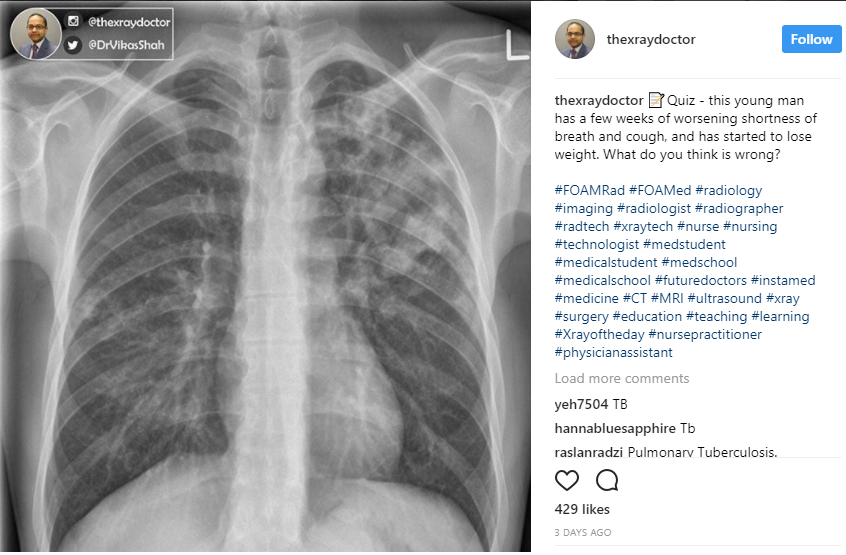Jisc has just announced its “top 10 higher education social media superstars” for 2017, and I was privileged to be on this year’s judging panel.
Whittling the entries down to just 10 was something of a challenge. To be eligible, individuals had to put themselves forward or be nominated by a colleague – so it wasn’t simply a case of picking out the biggest hitters based on follower numbers, or seniority.
Instead, I and my co-judges (Jisc’s social media team and Sarah Knight, the organisation’s head of change – student experience) had the pleasure of looking through some less obvious – but no less worthy – examples of social media excellence from across the UK sector.
Dr Vikas Shah, for example, who is academic champion in clinical radiology/imaging University of Leicester, has amassed tens of thousands of followers on Instagram where he is known as the X-Ray Doctor. He regularly posts interesting x-rays, including pop quizzes for his students (see below).

Meanwhile, other superstars include Peter Klappa, reader in biochemistry at the University of Kent, who has embedded Facebook Live lecturers into his courses (and has thousands of people subscribing to his videos on YouTube too); Anastasia Denisova, journalism lecturer and researcher in viral cultures University of Westminster, who uses Twitter to source immediate feedback on research; and Keith Brown, e-learning and technology development officer at the University of Bath, who developed a new social network in order to help those reluctant to share online to embrace social media.
Oh yes, and then there’s Pablo the library penguin. He spends his days hard at work at the University of Portsmouth, offering advice, information and guidance to students looking to find out more about their library. It’s all good fun, but also incredibly useful.
If you want to work in a booth, but find a giant penguin there, just tell him he has to share. Library space is for everyone, not just Pip. pic.twitter.com/yy4g4mawml
— UoPLibrary Penguin (@uoppenguin) November 7, 2017
Without further ado, then, here – in alphabetical order – are your 10 higher education social media superstars for 2017.
The Jisc top 10 HE social media superstars of 2017
Andy Tattersall
Information specialist at the School of Health and Related Research, University of Sheffield
Creator and contributor to ScHARR’s YouTube channel, Andy’s video series include ScHARR Bite Size series – which teaches the viewer “something new in 20 minutes”. His Research Hacks series contains 44 helpful videos, and the more recent Cite Hacks series features engaging illustrations and information – such as this video that covers blogging about your research.
As well as @Andy_Tattersall, Andy can be found tweeting from @ScHARRSheffield and @MultiMediaIT.
Judges’ comments
Andy’s use of YouTube playlists to give bite-sized information is a really effective way to share knowledge simply with colleagues and peers across the world. We thought the Cite Hacks series was particularly good.
Anastasia Denisova
Journalism lecturer and researcher in viral cultures, University of Westminster
Anastasia practises what she preaches – as she shares and discusses her own research, research updates, and the wider news agenda on Twitter. Her conversations spark interest and engagement from her students, fellow researchers and even journalists looking for commentary.
Judges’ comments
Using Twitter as a sounding board for immediate feedback on research is a great use of the platform. Anastasia’s approach to the multi-benefits of Twitter sets a valuable example that others in HE could follow.
Christina Stanley
Lecturer in animal behaviour and welfare, University of Chester
When asked to design a new module in line with her research interests, Christina Stanley’s first thoughts were: “Brilliant! But how can I ensure this is fun and engaging?” Realising the importance of embedding employability skills into teaching, and after inspiring conversations with colleagues, Christina realised an innovative use of Twitter was the answer.
Christina shared relevant papers with her students, and inspired them to do the same, even using Twitter as an assessment tool, using the hashtag #BI6192. The Twitter feed was embedded on the module’s eLearning site.
Judges’ comments
Despite Christina confessing to not always having been a Twitter "believer", we thought her use of Twitter as an assessment tool was very innovative and had the incredibly valuable benefit of helping students develop their communication skills.
Glenn Hurst
Department of chemistry lecturer, University of York
As well as using Twitter to engage with students and the academic community, Glenn Hurst uses social media to enhance the quality of his teaching – by empowering students to create their own YouTube videos of organic chemistry mechanisms. Students then tweet their videos to him to receive feedback so they can improve.
Glenn also uses Snapchat to signpost students during inductions, allowing them “to contextualise the chemistry concepts we teach in lectures to the real world".
In collaboration with colleagues and students, Glenn has also contributed to the construction of a Chemistry@York app for applicants and visitors to the department of chemistry. The app has been downloaded by more than 500 individuals from across the globe.
Judges’ comments
Snapchat has plenty of potential to reach a student audience and we were really excited to read about how Glenn uses it to give students a glimpse of chemistry research in a laboratory – a really clever use of the platform.
Kardi Somerfield
Senior lecturer in marketing, University of Northampton
Kardi Somerfield uses Twitter in several ways to help her students to keep up with advertising and marketing practice. The AdStudent Picks list is a set of accounts for students to follow. It keeps students up to date with the trade press and breaking campaigns, while building familiarity with agencies, clients and issues. Kardi promotes the use of #AdStudents, to highlight posts from the advertising student community across the three years of study and beyond to alumni.
Her use of social media has resulted in the launch of a "student takeover" of the university social media accounts. Final-year students will be given the experience of working in the digital team, as well as being matched with skilled practitioners who will continue to mentor them into their first roles in industry.
Kardi has also invited community organisations to have social media content created for them by digital marketing students, an initiative recently shortlisted for a Changemaker Award.
Judges’ comments
Kardi provides a brilliant example of how to integrate social media throughout a programme – from a resource of industry news to using it to provide real-world experiences. The AdStudent Picks Twitter list is a great way to get students engaging with the platform.
Keith Brown
E-learning and technology development officer, University of Bath
Demonstrating that there’s no “one size fits all” when it comes to social media, Keith has created Study-Space, a private social media app used at the University of Bath, developed and used by about 800 students. The app includes the options to post quizzes, surveys and voting competitions, as well as posting questions and text.
Study-Space proves useful for students and lecturers alike, especially for those who do not wish to use their own personal social media account for work or study, or who might have had negative experiences with social media in the past.
Judges’ comments
Social media can present a number of barriers to people, so we thought Keith’s bespoke Study-Space platform was such a creative and useful solution that many others in the sector would want to hear about.
Pablo the library penguin
Library penguin, University of Portsmouth
Pablo works with the University of Portsmouth Library to build trust and engagement between university students and library services and facilities. He proactively enhances the library brand across social media, lowering barriers to service engagement, and engaging students, while demonstrating empathy and providing a quirky take on often serious messages.
Behind the scenes, he has provided opportunities for staff at the University of Portsmouth Library to explore and rediscover their own library from new angles, as well as boosting morale through challenging times of change.
Through his interaction with services and facilities Pablo offers a humorous sideways look at the library – you can even watch his movie here.
Judges’ comments
As he’s done with his followers on Twitter, Pablo the library penguin stole our hearts. A truly fantastic way to engage students with library services and facilities.
Peter Klappa
Reader in biochemistry, University of Kent
Peter Klappa is a keen user of Facebook Live, harnessing the power of social media to expand traditional teaching and learning spaces.
“Facebook Live streams can make learning more accessible for students, who find it difficult to attend face-to-face sessions or who are studying remotely," he says. Student feedback for Peter’s live streaming has been extremely positive – demonstrating that it can make learning on-the-go a lot easier and more accessible.
Furthermore, not every student uses Facebook and Peter is currently investigating other platforms, such as YouTube Live.
Judges’ comments
Peter is a shining example of how to make learning more accessible with technology. Facebook Live hasn’t had massive adoption in higher education learning yet but maybe Peter’s success will help to change that.
Roger Kerry
Associate professor, Faculty of Medicine & Health Sciences, University of Nottingham
Inspired by his earlier research into the educational use of Twitter among undergraduate physiotherapy students (sponsored by the Higher Education Academy), Roger has created a model of Twitter use that can be implemented into any programme to “enhance and expedite learning and access to knowledge and debate”. The project is called TWEED (Twitter in education).
“Following this, I went one step further and three years ago introduced a blogging assignment as part of the summative assessment for a postgraduate module I run. The underpinning theory for this is all about developing students’ critical writing and thinking skills via their awareness that what they write will be immediately open to wide public scrutiny,” he says.
Judges’ comments
Roger is a great ambassador of social media in education. He has been able to prove its value many, many times, not least with students securing employment from the networks they are encouraged to build.
Vikas Shah
Academic champion in clinical radiology/imaging, University of Leicester
With his impressive Instagram following, Vikas is bringing radiology to the masses. In addition to image and video posts, he’s an active user of Instagram stories, using them to post new teaching material every few hours. Vikas has used the new “polls in stories” feature since day one, increasing engagement with his quiz posts.
His expertise in the field led to co-authoring an article in Academic Radiology on the use of #SoMe (social media) in radiology education, with promotion of this article via the hashtag #SoMe, yielding the highest Altmetric score for any article in that journal this year.
Judges’ comments
We thought Vikas provided the perfect example of how to carve a niche on a social media platform and build an audience. His Instagram profile provides a fascinating look at the world of radiology.




